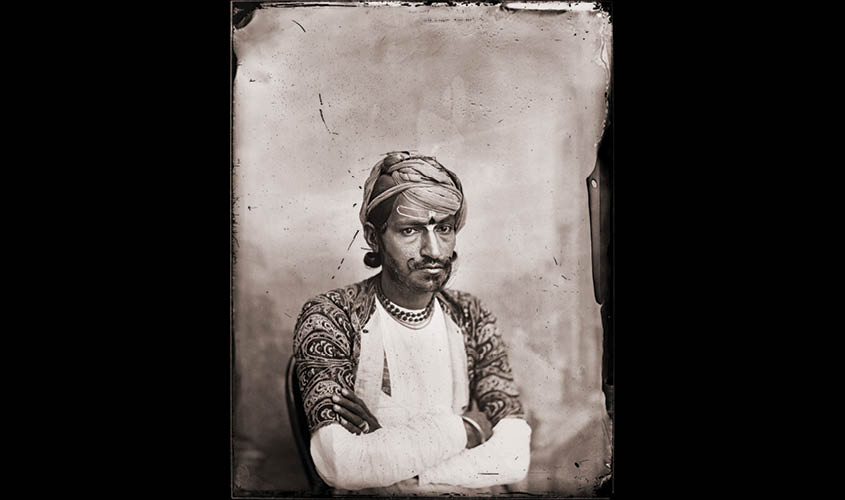A new exhibition hosted by Delhi’s Triveni Kala Sangam features digital prints of a selection of photos taken by Sawai Ram Singh II, the 19th-century maharaja of Jaipur who was among the very first portrait photographers in India, writes Sneha Gohri.
Sawai Ram Singh II, the maharaja of Jaipur from 1835 to 1880, is ranked among the pioneering portrait photographers in India. He was also among the first few photographers who took pictures not of the high and mighty, but of ordinary men and women. A selection of these photos is now on display at an ongoing exhibition at Delhi’s Triveni Kala Sangam.
A Reflective Oeuvre: The Pioneering Photographs of Maharaja Sawai Ram Singh II features digital prints of Ram Singh’s photos of late-19th century Jaipur and its denizens. What makes the exhibition interesting is the fact that these photos date back to Ram Singh’s own reign. A king has portrayed his subjects. How often do we see that?
Dr Giles Tillotson, consultant for the City Palace Museum in Jaipur and one of the curators of this exhibition, says, “The people who met Maharaja Sawai Ram Singh knew that he was a photographer and that he was very good at it. But when he died in 1880, his studio was sealed. His role [as a photographer] was completely forgotten for over a hundred years. What we are trying to do now is to bring his works to a much wider audience. Of the 2,000 negatives, we have about fifty on display here.”
Several portraits exhibited here are of members of Ram Singh’s royal court. Many of his portrait subjects were women, from his harem. This adds further value to the collection, for it is rare to find such striking portraits of women from that era. These were some of the first photos taken of women during the British Raj, at a time when the “purdah” practice was prevalent.
Art historian Laura Weinstein, who has done research on Ram Singh’s work, calls these photos “completely without precedent”. That has to do with the way the women have been portrayed—not as docile members of a patriarchal society but as independent, thoughtful human beings. In one of the photos, the woman subject is standing beside a shelf full of books, a totally unusual setting as per conventional portraiture.
“The zenana portraits,” says Weinstein, “reveal no sickness or dirt, depraved or deviant faces, exposed bodies or sexually suggestive poses.”

The maharaja, a committed photographer, also did not mind going out of his comfort zone. He took photos of the locals and of Jaipur’s buildings, creating a visual record that was almost journalistic in nature. This urge to go the extra mile often took him to foreign shores, where he took photos of world famous paintings, like the Raphael Sistine Chapel frescoes.
At times, he turned the camera on himself. Ram Singh was a keen self-portraitist more than a century before the advent of the selfie; working in the tradition of early Indian photographers like Darogha Abbas Ali and Ahmad Ali Khan. These photos show Ram Singh dressed in full royal regalia. In some, he is wearing a serious look on his face, gazing directly towards the camera.
An air of anonymity surrounds these photos. The portraits have no names attached to them, implying that the collection was meant to be a private affair.
At the Delhi show, the focus is on Ram Singh’s photos. But an accompanying series of digital artworks, by the contemporary artist Nandan Ghiya, has also been displayed at the venue.
Ghiya says he feels privileged to be sharing exhibition space with the maharaja’s work. “It is an overview of the period when photography was invented,” he says about the present show. “Photography was a new medium back then, and it is interesting to see how a person like the Maharaja interacted with that medium.”
Though he works with photos, Ghiya does not consider himself a photographer. His work is more in tune with our computerised age. The Internet, the social media and the varied of tools of digital technology are among his preferred themes. His works Chairmen and #MeninRed are inspired by the idea of search results on the Internet. He is further interested in exploring how the art of image-making in our time is governed by keywords and hash tags. Today, as he says, “a collective of images become one image”.
There is a link between the two segments of this exhibition. What Ram Singh did over a century ago, by pushing the boundaries of the photographic form, Nandan Ghiya is doing today. Since Ghiya mostly works with black-and-white archival images, one can perceive aesthetic similarities between his work and Ram Singh’s.
The exhibition, which opened on World Photography Day, 19 August, is on view till 18 September

